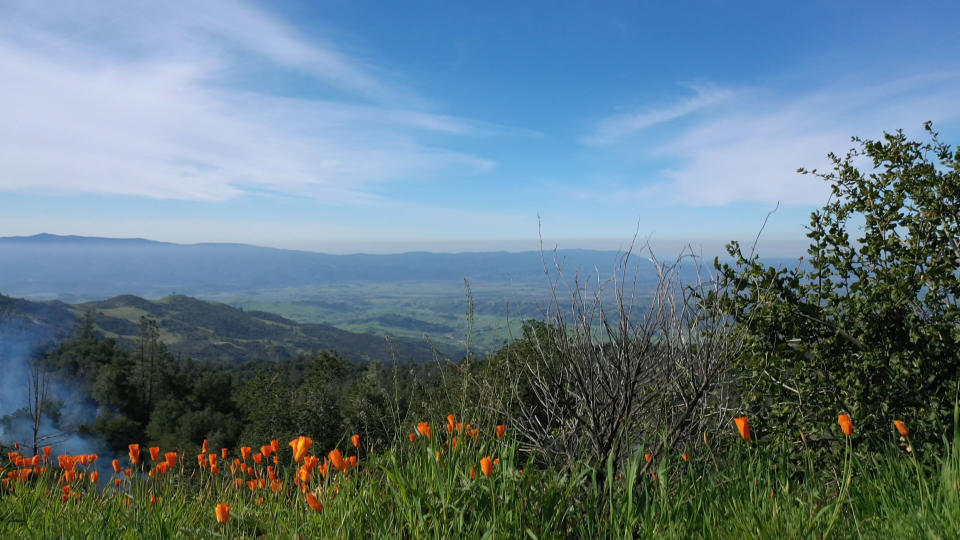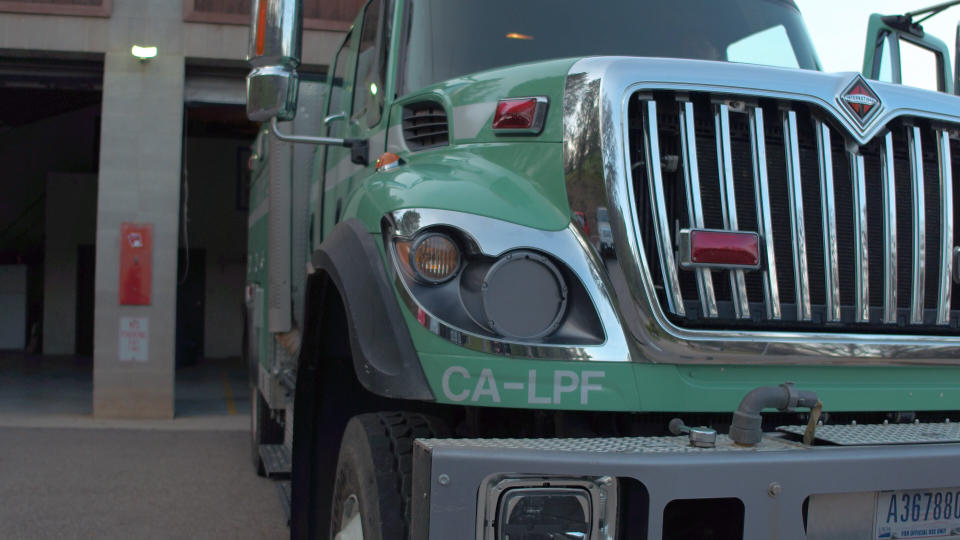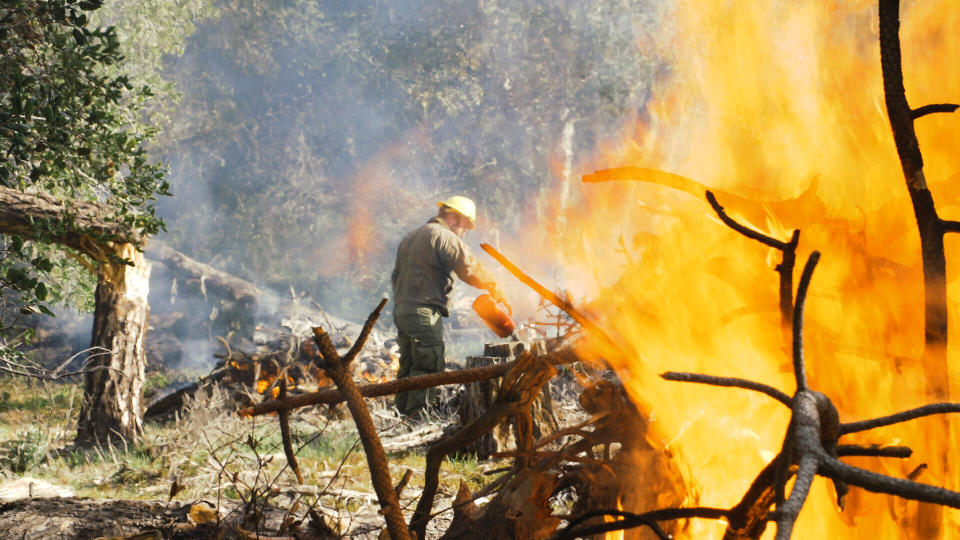2018 was the deadliest fire season in California's history; these firefighters are on the front lines
(Video Produced by Gaby Levesque)
May 3, 2019 — On Figueroa Mountain about two hours north of Los Angeles in Los Padres National Forest, the hillside was covered in orange poppies and a thick layer of smoke in late March of this year. Even with the growing plumes of thick floating embers, there was no need for alarm. Below the canopy of trees at the fire line, hidden from view were the men and women of the U.S. Forest Service, the ones setting fire to the forest with the intention of letting it burn. With fire season already underway, these wild-land firefighters were doing work to avert the catastrophic fires that ran through California in 2018.

That year, 2018, marked the deadliest fire season in California’s history, during which more than 100 people were killed. The Camp Fire in Butte County alone resulted in 85 fatalities, 153,336 acres burned and 18,804 structures lost. The Mendocino Fire that ignited in July of last year was the single largest fire in recorded history to burn through the state, leaving 459,123 charred acres in its wake. That’s 177,230 acres more than burned in the Thomas Fire, the second most destructive fire that occurred just the year before.
“Within the last five or six years, it seems like fire season is 365 days a year,” Matthew Guzman, a wildfire prevention captain at the Los Padres National Forest, told Yahoo News.
“Unfortunately, over the past decade or so, it seems like fires are getting much larger and I don't think there is one thing to point at that; there's a lot of contributing factors to that. I do believe they are getting bigger faster, ” said Jeremy Blake of Flight Crew (Helicopter-527) of Arroyo Grande, Calif.
The destructive aftermath of last year’s fires and the possibility that they could very well happen again this year is a fact not lost on California’s politicians and firefighters. On March 22, Gov. Gavin Newsom declared a state of emergency in California and expedited forest management projects to protect communities and lives across the state.
On the front lines of carrying out these management tasks, the U.S. Forest Service employs about 10,000 wild-land firefighters who maintain the land and put out fires in some of this nation’s most remote and desolate areas. Although the number varies from year to year, about half of these individuals work in the Pacific Southwest Region. These men and women typically take their green water tankers to the location of fires raging through the wilderness.

More than 73,000 wildfires burn an average of about 7 million acres of private, state and federal land in the United States each year, and the typically behind-the-scenes team members from the Forest Service are the first ones on-site. In many cases, they’re called to locations that aren't accessible by land vehicles, so the firefighters are flown out to battle the blazes. Left on location in the wilderness for up to two weeks at a time, they are expected to stay on-site battling the fires until the job is done.
These unique and often overlooked firefighters don’t use the typical tools you would expect to see on location at a fire: They typically use fire to fight fire.
When they’re not out fighting raging fires, the firefighters and fire technicians of the Forest Service carry out prescribed and controlled burns in the months outside of the fire season. During the winter and spring, they run low-intensity and controlled fires through the forest floors to reduce fire fuels that build up over the years. The fuels they seek to mitigate are dead trees, dried leaves, pine needles and limbs from the tree canopy, which create a major hazard to the ecosystem as they pile up on the forest floor. Burning them in a controlled environment during the offseason is one of the many ways these firefighters manage the forest in Southern California.
Once the land has been scorched, subsequent fires can’t burn through that same area and are stopped from spreading to nearby communities at the forest’s edge. “Wildfire season in the United States usually starts late April,” said Guzman. As the temperatures start to rise in the West, so do the chances of fires starting.
Last year, after forest fires that rocked the state, President Trump directed blame at these very same firefighters and threatened to withhold federal aid from the state.
“There is no reason for these massive, deadly and costly fires in California except that forest management is so poor,” Trump tweeted. “Billions of dollars are given each year, with so many lives lost, all because of gross mismanagement of the forests. Remedy now or no more Fed payments!”
Many Californians have placed the blame for last year’s Camp Fire on Pacific Gas and Electric Co., the power company that provides electricity to the northern two-thirds of the state. Officials at the company, which filed for bankruptcy in January, have said it is probable that faulty equipment may have started the blaze that leveled the town of Paradise.
For many Forest Service employees, however, assessing blame is not a simple matter.
"The easy answer is to point at us and say maybe we're not doing our job or the power companies aren't keeping up to date on their equipment, but in reality they're [residents] in higher fire-prone areas," said Mike Fuerich, a member of the Santa Lucia Dozer team.
Although these companies might be held responsible for starting these fires, how fast and easily these fires spread is an equally large concern. According to Fuerich and other firefighters interviewed by Yahoo News, an understanding of how wildfires are a natural part of the ecosystem, as well as how urban sprawl is encroaching on areas that are naturally prone to burn, is key to understanding why these catastrophic fires reach the levels of destruction that they do.
A way to reduce the chances of these large fires occurring is to conduct controlled fires throughout the region, and the firefighters believe that more work like this should be done every day during the winter months. Getting work like prescribed burns done is essential to the management of the forest.

The Forest Service members we spoke to found it ironic that the government shutdown that resulted from Trump’s demands that Congress fund a wall along the border with Mexico made it even harder for them to do their jobs. As federal employees, around three-quarters of the force was furloughed for 34 days when they could have been conducting controlled burns.
“The government shutdown may seem like old news; there’s still a little bit of a linger from that,” Guzman said.
Fuerich agreed. “The furlough definitely put us behind on work. You know, we have all these fuels projects lined up for the wintertime and the weather was permitted for us to go out, but when more than three-quarters of our force is laid off, or temporarily laid off, there’s not much work you can really do except the minimal staffing in case there are fires,” he said.
The firefighters in Los Padres National Forest agree that climate change and the general increase in temperature year to year may have an effect on the intensity of these fires in California, but most believe that many other factors contribute to the growing scale of these catastrophic fires. “There is no one solution to fix why we have devastating fires,” said Blake. “There are numerous reasons why we have large fires and why they grow so large, from the drought that California has been in to all of the tree mortality that we've had, to the ever-expanding urban interface situations that we face.”
As the population grows in California, residential communities have encroached closer on the forest. This type of sprawl is what most of the Los Padres National Forest firefighters believe is the biggest threat to the growing size of these large fires. As homes get closer to the forest, firefighters say, homeowners need to work on making sure that their house has a fair shot at surviving a catastrophic fire.
Homeowners are advised to “do their homework on the area that they live in and understand the risks involved and understand that fire is a natural part of the environment and it’s not going anywhere. They need to take the steps to do their clearance and do the research involved to show how their house can survive a catastrophic incident like a wildfire,” said David Bryden, an assistant engineer at Figueroa Mountain Station. “Homeowners can clear the property, clear any fuels around their house and maintain awareness of what level of fire hazard their home is in and what they need to do to prevent that.”
The firefighters believe that if homeowners did their part to clear the area around the homes of these hazardous and flammable fuels, fires would be less likely to sweep so swiftly through communities close to the forest.
More than 2.7 million Californians live in areas deemed to be at very high risk of wildfires. This amounts to 1 in 12 homes in the state, and about 180 cities and towns are considered to be in very fire-prone areas. Residents in the areas surrounding the forest need to stay up to date on how to best protect their properties from natural disasters, just as residents in Florida have to prepare their homes for hurricanes.
“Fire is a natural part of California and the land here has been developed to burn and it’s intended to burn, it’s every bit as normal as any other weather pattern,” Bryden said. “We need to remember that all of this was intended to burn and we’re fighting against Mother Nature in preventing fires.”
If you’re interested in learning more about how to best prepare your home and property for a catastrophic fire, you can get more information at this site or reach out to your local fire department.

